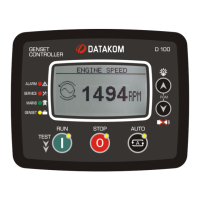D-100 MK2 User Manual Firmware V-6.3
K96D01-EN - 106 -
The controller is able to manage the supply of up to 5 prioritized loads. The loads are supplied starting
from the number #1 (highest priority) and unloaded from the highest number (lowest priority) available.
Protection timers help to stabilizing the decision algorithm and preventing unwanted multiple operations.
When the load is below the Multi Load Add Power Level during Multi Load Add Start Delay, then 1
step of load is added. The minimum wait period between two load_adds is Multi Load Add Wait Delay.
When the load is above the Multi Load subtract Power Level during Multi Load subtract Start Delay,
then 1 step of load is unloaded. The minimum wait period between two load_subtracts is Multi Load
Subtract Wait Delay.
Add and subtract outputs send pulses of 0.25s duration.
The parameters used in Load Shedding feature are in the Electrical Parameters Group:
Multi Load Subtract Power Level: When the genset active power goes over this limit, the controller will
start subtracting load.
Multi Load Add Power Level: When the genset active power goes below this limit, the controller will
start adding load.
Multi Load Subtract Start Delay (tLSD): If the load stays over the Multi Load Subtract Power Level
parameter during this timer, then 1 step of load is subtracted.
Multi Load Subtract Wait Delay (tLSW): This is the minimum period between two load subtract pulses.
Multi Load Add Start Delay (tLAD): If the load stays below the Multi Load Add Power Level parameter
during this timer, then 1 step of load is added.
Multi Load Add Wait Delay (tLAW): This is the minimum period between two load add pulses.
t1: the load goes below the Multi Load Add Power Level.
t2: after Multi Load Add Start Delay the load is still below Multi Load Add Power Level, the Load_Add_1
sends a pulse.
t3: after Multi Load Add Start Delay and Multi Load Add Wait Delay, the load is still below Multi Load Add
Power Level, thus Load_Add_2 output sends a pulse.
t4: the load goes above the Multi Load Subtract Power Level.
t5: after Multi Load Subtract Start Delay, the load is still above Multi Load Subtract Power Level, thus the
Load_Substract_2 sends a pulse.
t6: the load goes above the Multi Load Subtract Power Level.
t7: Multi Load Subtract Wait Delay is already expired. After Multi Load Subtract Start Delay, the load is still
above Multi Load Subtract Power Level, thus the Load_Subtract_1 output sends a pulse.
25.3. FIVE STEP LOAD MANAGEMENT

